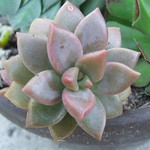Ghost Plant

 More than a dozen species make up the Graptopetalum family. They are a type of Crassulacae native to Mexico. Although they are similar in appearance to echeverias because of the rosettes they form, graptopetalums are considered closer relatives to sedum.
More than a dozen species make up the Graptopetalum family. They are a type of Crassulacae native to Mexico. Although they are similar in appearance to echeverias because of the rosettes they form, graptopetalums are considered closer relatives to sedum. A popular member of this succulent family is the Graptopetalum paraguayense, commonly known as Mother-of-Pearl or Ghost plant. Its name comes from the pale color of the leaves, which range from light blue-green to grayish pink. When the plant is grown in a sunny location the pink tints prevail. In a more shady area the leaves will have more of a blue tint.
The stems of the ghost plant are trailing rather than upright, making this plant a great “spiller” in a container garden. The plump leaves do break off rather easily. The good news is that the leaves can be placed upright in sandy soil where they will root and form new plants. The stems also take root where they come in contact with the soil.
When grown in a container the ghost plant should be watered thoroughly enough so water comes out of the bottom of the pot. It should then be allowed to dry before watering it again. Take care not to wet the leaves when watering because this can cause spotting. A watering can with a slender spout is helpful for getting water down to the soil where it belongs.
In the winter water should be cut back so the plant has just enough moisture to prevent the leaves from becoming shriveled. The ghost plant can survive temperatures down to the mid-twenties (Fahrenheit). In colder areas the plant should be protected or brought indoors.
In the spring the plant can be gently repotted if necessary. This is a good time to use broken-off leaves or stems to make new plants.
Summer is when you can expect blooms. Like many other succulents, the flowers appear on the ends of long stalks. The tiny white star-shape flowers have yellow centers with stamens that curve out.
Ghost plants are easy to find in nurseries and easy to grow. They thrive on little care and have few pests, except for the mealybug.
A plant similar in appearance to the ghost plant is Graptoveria ‘Fred Ives.’ It is a hybrid of Echeveria and Graptopetalum with larger rosettes – up to six inches in diameter.
This site needs an editor - click to learn more!

Related Articles
Editor's Picks Articles
Top Ten Articles
Previous Features
Site Map
Content copyright © 2023 by Linda Genis. All rights reserved.
This content was written by Linda Genis. If you wish to use this content in any manner, you need written permission. Contact
BellaOnline Administration
for details.


